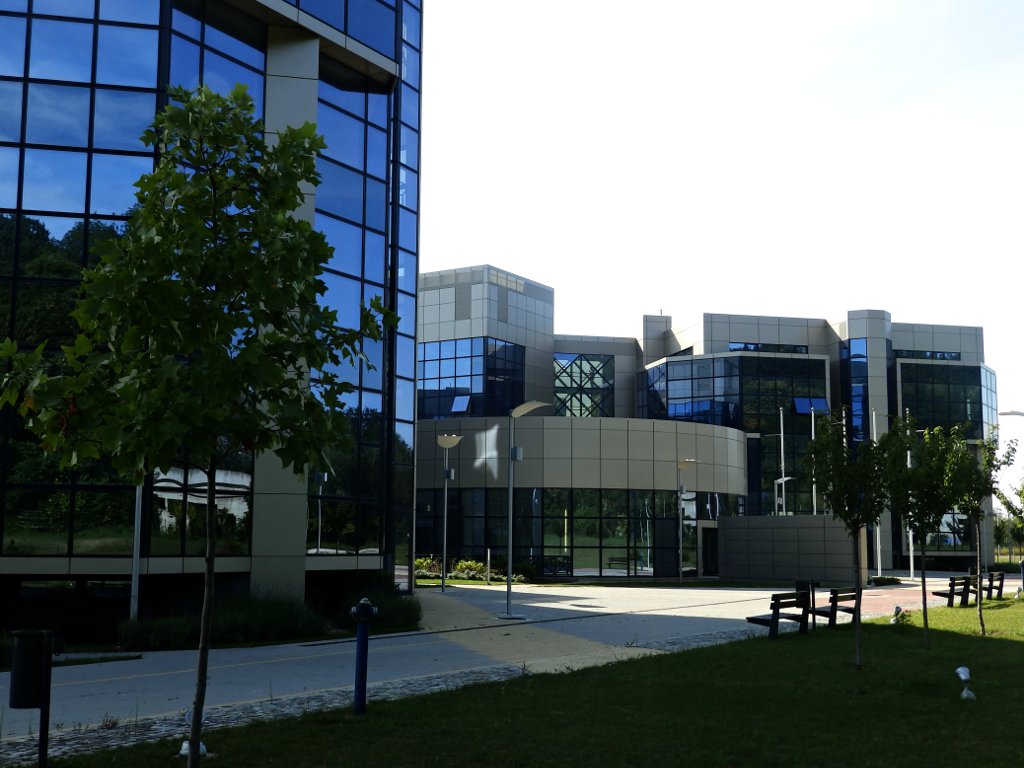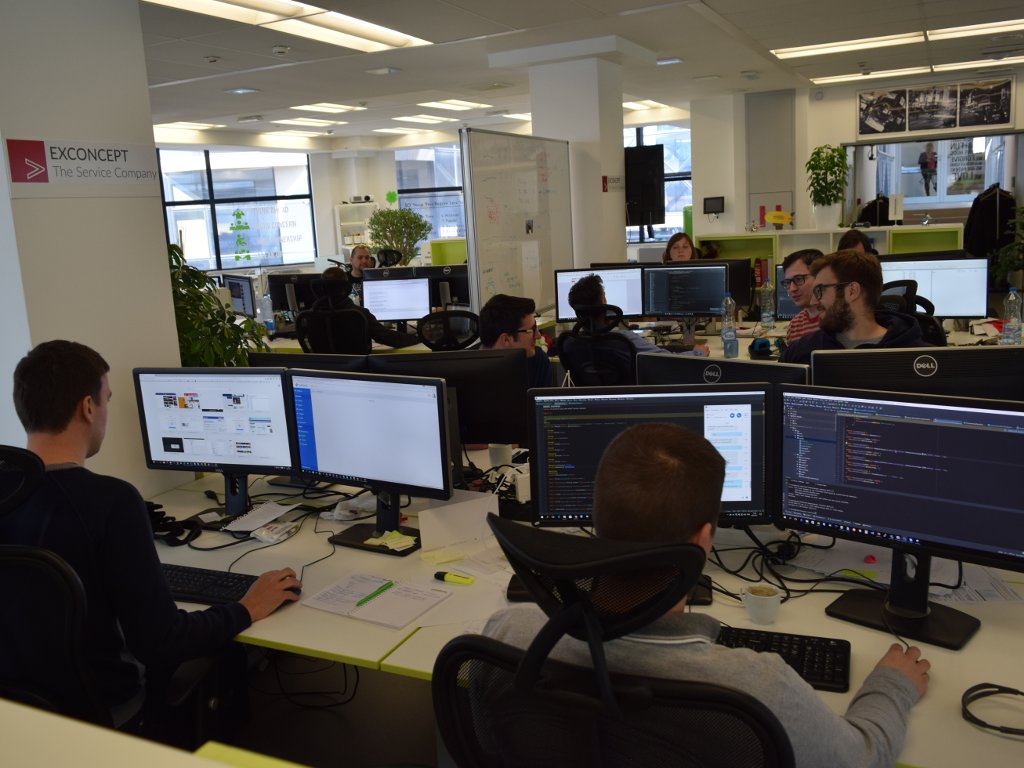Companies at Science-Technology Park Belgrade making millions in revenues and export – Factory of the future to be employing 700 young engineers by the end of 2018
From ghost town to knowledge factory – that was the development of the Science-Technology Park Belgrade. Since the opening in 2015, around 500 young experts have been employed here, and their companies had revenues of around EUR 10 million and exports worth EUR 6 million last year.
The 11,000-m2, five-building complex in the Zvezdara forest now features around sixty companies. Slightly under a half of them are technology-development companies and the rest are startups. In addition to the space and technological infrastructure, the residents also get the much more important business support and motivation. They are provided with access to knowledge bases and financial funds and they learn about certification processes, promotion, networking and internationalization.
Lean Pay, a young Belgrade-based company, has been operating in the Zvezdara park for a year and a half now. They are developing a platform enabling the purchase of goods and services in installments at online shops, and their product will be made available in the EU market in less than a month.
– Aside from the premises, which was very important to us, we have been provided with business support at the Science-Technology Park as well. We've taken part in several conferences and got an opportunity to be guests of an accelerator program in Israel for a few weeks. This was of great importance to us when it comes to perfecting the product – says Misa Zivic, co-founder of the company.
When they came to the Zvezdara complex, he points out, they were working on a project which had little in common with their current idea.
– We were learning about the best ways to develop our own product and how to adapt to the market. Thanks to this, our service will soon start working in Slovenia, and the product we are developing here will therefore be used in the European market.
The development of a stimulating environment to the end of an accelerated technological development of Serbia and the support to technological entrepreneurship in commercializing innovations are at the foundation of the vision of the Science-Technology Park Belgrade. The European Commission, which promoted the park as a good example from the region, has also praised the results achieved there in the two years it has existed, and the STP Belgrade joined the biggest global community of technology parks, IASP, last month in Istanbul.
The road, however, was thorny.
Namely, the world is already seeing the development of the fourth generation of technological parks, and, at the time the STP Belgrade started operating (1989), the first one was only emerging. The 1990s left their mark in this field as well and it was only several years ago, thanks to an initial support by the Swiss government, that the conditions were met for the idea about the first institution of this type in Serbia to be finally brought to life. The buildings, which had been empty for years, were adapted to purpose, and an own model of regional development needed to be developed in line with the international practice and with support by the parks in the region. The park officially opened in October 2015, leaning on the considerable experience of the Business-Technology Incubator, founded at the initiative of the technical faculties in Belgrade.
The 11,000-m2, five-building complex in the Zvezdara forest now features around sixty companies. Slightly under a half of them are technology-development companies and the rest are startups. In addition to the space and technological infrastructure, the residents also get the much more important business support and motivation. They are provided with access to knowledge bases and financial funds and they learn about certification processes, promotion, networking and internationalization.
Lean Pay, a young Belgrade-based company, has been operating in the Zvezdara park for a year and a half now. They are developing a platform enabling the purchase of goods and services in installments at online shops, and their product will be made available in the EU market in less than a month.
– Aside from the premises, which was very important to us, we have been provided with business support at the Science-Technology Park as well. We've taken part in several conferences and got an opportunity to be guests of an accelerator program in Israel for a few weeks. This was of great importance to us when it comes to perfecting the product – says Misa Zivic, co-founder of the company.
When they came to the Zvezdara complex, he points out, they were working on a project which had little in common with their current idea.
– We were learning about the best ways to develop our own product and how to adapt to the market. Thanks to this, our service will soon start working in Slovenia, and the product we are developing here will therefore be used in the European market.
The development of a stimulating environment to the end of an accelerated technological development of Serbia and the support to technological entrepreneurship in commercializing innovations are at the foundation of the vision of the Science-Technology Park Belgrade. The European Commission, which promoted the park as a good example from the region, has also praised the results achieved there in the two years it has existed, and the STP Belgrade joined the biggest global community of technology parks, IASP, last month in Istanbul.
The road, however, was thorny.
Namely, the world is already seeing the development of the fourth generation of technological parks, and, at the time the STP Belgrade started operating (1989), the first one was only emerging. The 1990s left their mark in this field as well and it was only several years ago, thanks to an initial support by the Swiss government, that the conditions were met for the idea about the first institution of this type in Serbia to be finally brought to life. The buildings, which had been empty for years, were adapted to purpose, and an own model of regional development needed to be developed in line with the international practice and with support by the parks in the region. The park officially opened in October 2015, leaning on the considerable experience of the Business-Technology Incubator, founded at the initiative of the technical faculties in Belgrade.
– In 2015, our goal was to develop, together with the founders – the state, the City and the University, a model which could quickly make up for at least 20 missed years and keep up with global trends, a model which could develop our potentials quickly and provide an urgent response to the problems present in this field, primarily the brain-drain and the commercialization of innovations – says director of the STP Belgrade, Gordana Danilovic Grkovic.
As eKapija's interviewee explains, in the past years, Serbia has been recognized as a country with great innovative potentials in the field of knowledge, in science and research sectors, faculties and institutes, but the commercialization of those innovations is weak. The park therefore focused on bringing together as many technology-development companies as possible, encouraging young people to start their own companies in order to create a strong technological-business core capable of commercializing innovations and stimulating the global competitiveness of the local economy.
The Ministry of Economy points out that they are proud of the fact that, today, certain Swiss, Italian and German companies, and even companies from China and Latin America, have chosen to build their development centers at the Zvezdara park, where they develop new products and services in cooperation with our researchers. The results of the work of Serbian engineers are therefore sold throughout the world.
– The importance of the STP Belgrade for us, in addition to supporting young people in starting their own business and supporting technological companies, lies in the fact that now we have an opportunity to show in one place how important it is to invest in science and education and how much knowledge-based innovations can contribute to a country's development – says Professor Vladimir Popovic, state secretary at the Ministry of Education, Science and Technological Development.
In 2016, state investments in the Zvezdara park amounted to around EUR 350,000, and the revenues returned by the companies to the state that year, which was the first operational year for the park, amounted to EUR 2 million.
– If the park is capable of achieving this in its first year, imagine what it will be able to do in the upcoming years, when these companies grow even bigger – Danilovic Grkovic points out.
Sustainability takes time
The sustainability of such instruments of support to innovations is shown by examples in the region. The Science-Technology Park AREA Trieste carries out its activities on 80,000 m2, within 3 campuses, featuring modern, advanced scientific research equipment used by researchers from across the globe. The park belong to the public sector – they get EUR 7 million a year from the state and they return up to 40 million to the budget. The grant they receive from the relevant ministry provides them with a platform on which they base additional activities, which contribute the other two thirds of the income – partly commercial services, partly competitive projects in the region and in Europe.
As eKapija's interviewee explains, in the past years, Serbia has been recognized as a country with great innovative potentials in the field of knowledge, in science and research sectors, faculties and institutes, but the commercialization of those innovations is weak. The park therefore focused on bringing together as many technology-development companies as possible, encouraging young people to start their own companies in order to create a strong technological-business core capable of commercializing innovations and stimulating the global competitiveness of the local economy.
The Ministry of Economy points out that they are proud of the fact that, today, certain Swiss, Italian and German companies, and even companies from China and Latin America, have chosen to build their development centers at the Zvezdara park, where they develop new products and services in cooperation with our researchers. The results of the work of Serbian engineers are therefore sold throughout the world.
– The importance of the STP Belgrade for us, in addition to supporting young people in starting their own business and supporting technological companies, lies in the fact that now we have an opportunity to show in one place how important it is to invest in science and education and how much knowledge-based innovations can contribute to a country's development – says Professor Vladimir Popovic, state secretary at the Ministry of Education, Science and Technological Development.
In 2016, state investments in the Zvezdara park amounted to around EUR 350,000, and the revenues returned by the companies to the state that year, which was the first operational year for the park, amounted to EUR 2 million.
– If the park is capable of achieving this in its first year, imagine what it will be able to do in the upcoming years, when these companies grow even bigger – Danilovic Grkovic points out.
Sustainability takes time
The sustainability of such instruments of support to innovations is shown by examples in the region. The Science-Technology Park AREA Trieste carries out its activities on 80,000 m2, within 3 campuses, featuring modern, advanced scientific research equipment used by researchers from across the globe. The park belong to the public sector – they get EUR 7 million a year from the state and they return up to 40 million to the budget. The grant they receive from the relevant ministry provides them with a platform on which they base additional activities, which contribute the other two thirds of the income – partly commercial services, partly competitive projects in the region and in Europe.
The importance of such institutions is perhaps best described by Stephen Taylor, one of the managers of the Trieste park, which has been operating for 40 years. Ideally, he says, “if we do our job as well as we can, connecting the scientific community with the industry so that they work as one, our role will perhaps no longer be needed”.
– Until then, it is very important for there to be an adequate connection between science and economy and for the scientific results to find their way to the industry.
An even more pertinent example when it comes to the local market is the Technology Park in Ljubljana. In the 20 years of its operations, it has brought together around 300 companies, which make as much as EUR 350 million a year. The 9-building complex has almost no free space left. The taxes these companies pay through the pension and healthcare fund contribute EUR 7 million to the Slovenian budget annually. They received one grant of EUR 8 million as a structural fund for the construction of the park when they were starting. The rest was financed from their own credit (the total investment amounted to EUR 42 million). Thanks to the services they've developed, the park has been self-reliant for years now.
Iztok Lesjak, director of the Ljubljana Technology Park, says that achieving this kind of sustainability takes time, and he has only words of praise for its Serbian counterpart.
– The STP can grow even further organically – the startup scene is getting better and better, students graduate from faculties with a very good technological knowledge, and Belgrade provides additional possibilities for development as a big city. At the same time, there's also the potential for the entire endeavor and the industry to be transferred to other cities throughout the country through networking.
Although the support of the Ljubljana park has been of great importance for the one in Belgrade, the experience of others, Lesjak says, cannot be copied in this process, as each entrepreneurial environment is different, beginning with legal frameworks, people's habits, the knowledge, the circumstances.
Distribution of risk
The director of the Belgrade park points out that Serbia is, unfortunately, still a society in which entrepreneurship is discouraged and that institutions such as these are important precisely because they provide young people with support and a chance to meet other people doing similar things, thereby giving them an additional incentive to develop even faster and stronger.
She reminds that innovations are the carriers of any economy's competitiveness, but that they are also very risky as such. In the economies in which there is a system of support to innovations, numerous young people and companies decide to innovate, whereas in those that do not feature such a system the number is very small, as the risk is big.
– If the idea fails to get realized, it is only an individual failure, but if an innovation succeeds, the whole society benefits from it. For this reason, it is important for there to be a distribution of risk, and this is also why instruments of support to innovations, such as science-technology parks, are necessary.
The STP belgrade provides support to technology-development companies in the field of information technologies, biomedicine, new materials and nanoscience, energy efficiency, environmental protection, as well as innovative agriculture and food production. The plan is to have 80 companies operating within it by the end of 2018, for which purpose another building needs to be adapted.
– The government's initial goal was to reach this number in four years, and we would realize this in slightly under 3 years. This means that 600 to 700 young engineers will work here by the end of the next year – Danilovic Grkovic announces.
Let us remind that this institution was officially founded in June 2015 by a decision by the Government of Serbia, through a partnership of the government, the City of Belgrade and the University of Belgrade. The foundation was also supported by the Swiss State Secretariat for Economic Affairs (SECO). According to the adopted model, the missing funds for the overhead and administrative costs are covered by the government, whereas the city aids local activities (transport, entrepreneur affirmation etc.) and the rest is provided from the income of the companies within the park and the services they develop there.
Ivana Bezarevic
– Until then, it is very important for there to be an adequate connection between science and economy and for the scientific results to find their way to the industry.
An even more pertinent example when it comes to the local market is the Technology Park in Ljubljana. In the 20 years of its operations, it has brought together around 300 companies, which make as much as EUR 350 million a year. The 9-building complex has almost no free space left. The taxes these companies pay through the pension and healthcare fund contribute EUR 7 million to the Slovenian budget annually. They received one grant of EUR 8 million as a structural fund for the construction of the park when they were starting. The rest was financed from their own credit (the total investment amounted to EUR 42 million). Thanks to the services they've developed, the park has been self-reliant for years now.
Iztok Lesjak, director of the Ljubljana Technology Park, says that achieving this kind of sustainability takes time, and he has only words of praise for its Serbian counterpart.
– The STP can grow even further organically – the startup scene is getting better and better, students graduate from faculties with a very good technological knowledge, and Belgrade provides additional possibilities for development as a big city. At the same time, there's also the potential for the entire endeavor and the industry to be transferred to other cities throughout the country through networking.
Although the support of the Ljubljana park has been of great importance for the one in Belgrade, the experience of others, Lesjak says, cannot be copied in this process, as each entrepreneurial environment is different, beginning with legal frameworks, people's habits, the knowledge, the circumstances.
Distribution of risk
The director of the Belgrade park points out that Serbia is, unfortunately, still a society in which entrepreneurship is discouraged and that institutions such as these are important precisely because they provide young people with support and a chance to meet other people doing similar things, thereby giving them an additional incentive to develop even faster and stronger.
She reminds that innovations are the carriers of any economy's competitiveness, but that they are also very risky as such. In the economies in which there is a system of support to innovations, numerous young people and companies decide to innovate, whereas in those that do not feature such a system the number is very small, as the risk is big.
– If the idea fails to get realized, it is only an individual failure, but if an innovation succeeds, the whole society benefits from it. For this reason, it is important for there to be a distribution of risk, and this is also why instruments of support to innovations, such as science-technology parks, are necessary.
The STP belgrade provides support to technology-development companies in the field of information technologies, biomedicine, new materials and nanoscience, energy efficiency, environmental protection, as well as innovative agriculture and food production. The plan is to have 80 companies operating within it by the end of 2018, for which purpose another building needs to be adapted.
– The government's initial goal was to reach this number in four years, and we would realize this in slightly under 3 years. This means that 600 to 700 young engineers will work here by the end of the next year – Danilovic Grkovic announces.
Let us remind that this institution was officially founded in June 2015 by a decision by the Government of Serbia, through a partnership of the government, the City of Belgrade and the University of Belgrade. The foundation was also supported by the Swiss State Secretariat for Economic Affairs (SECO). According to the adopted model, the missing funds for the overhead and administrative costs are covered by the government, whereas the city aids local activities (transport, entrepreneur affirmation etc.) and the rest is provided from the income of the companies within the park and the services they develop there.
Ivana Bezarevic
Companies:
Naučno-tehnološki park Beograd
Vlada Republike Srbije
Grad Beograd
Univerzitet u Beogradu
Ministarstvo prosvete Republike Srbije
AREA Science Park Trieste
Staatssekretariat für Wirtschaft SECO Bern
Poslovno tehnološki inkubator tehničkih fakulteta d.o.o. Beograd
Tags:
Share:






Only logged-in users can comment.


 Izdanje Srbija
Izdanje Srbija Serbia Edition
Serbia Edition Serbische Ausgabe
Serbische Ausgabe Izdanje BiH
Izdanje BiH Izdanje Crna Gora
Izdanje Crna Gora









 LinkedIn
LinkedIn Copy link
Copy link




